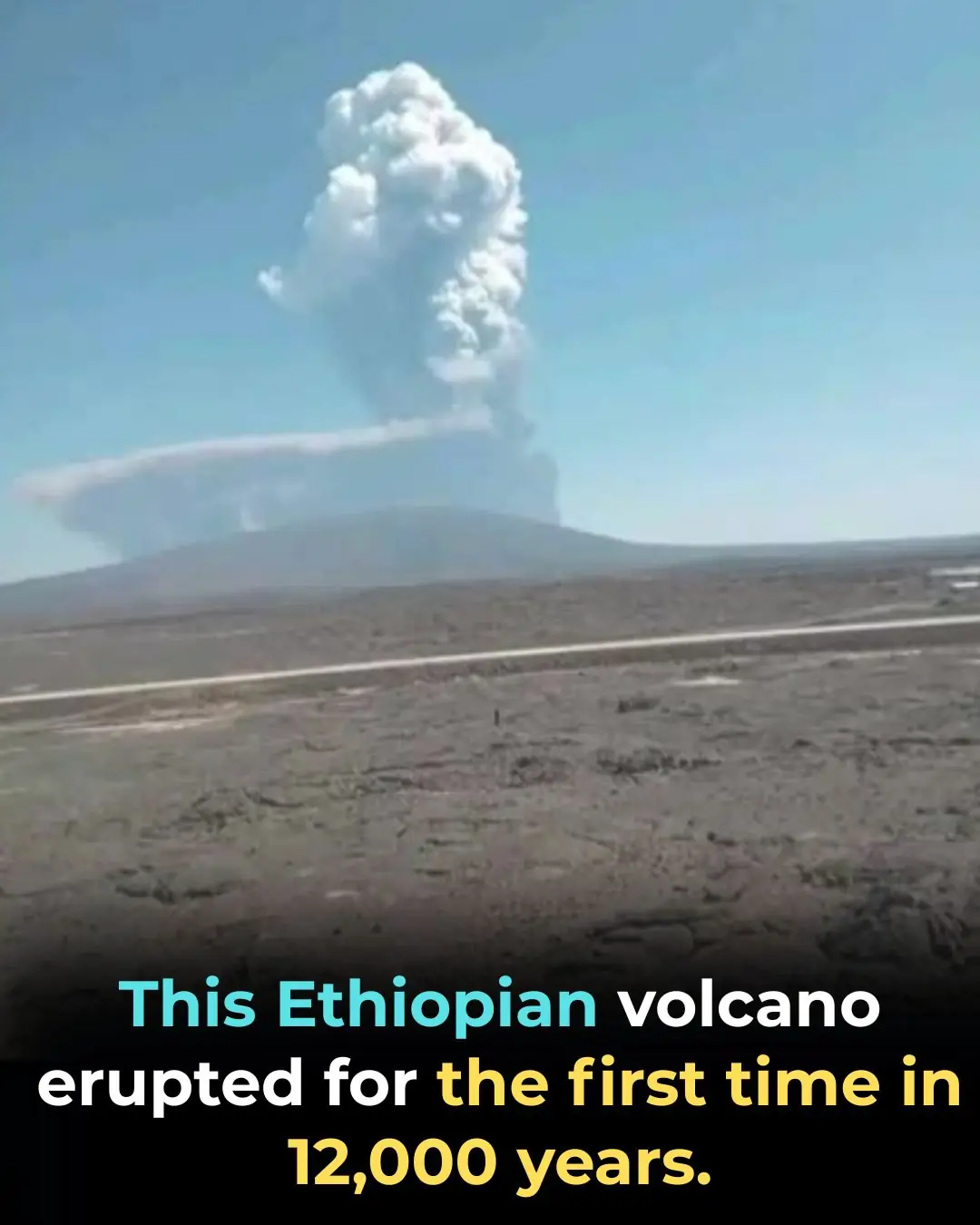
Hayli Gubbi Volcano Erupts in Ethiopia for First Time in 12,000 Years



On November 23, 2025, a remarkable geological event unfolded in Ethiopia — the Hayli Gubbi volcano erupted for the first time in nearly 12,000 years, shocking scientists and local communities alike.
Located in the remote Afar Region in northeastern Ethiopia — approximately 500 miles (about 800 kilometres) northeast of the capital Addis Ababa and near the border with Eritrea — Hayli Gubbi erupted violently after millennia of silence.
The Eruption and Its Scope
According to international monitoring by the Toulouse Volcanic Ash Advisory Center (VAAC), the eruption expelled massive ash and smoke plumes soaring as high as 9 miles (approximately 14 km) into the sky. Some reports even estimate the ash column reached up to 14 km (45,000 ft).
Satellite imagery — including images captured by NASA — clearly shows a vast plume of volcanic ash drifting eastward over the Red Sea and onward toward the Arabian Peninsula and beyond.According to observers, the plume’s trajectory carried it over countries such as Yemen, Oman, and further toward South Asia and northern Pakistan.
Local witnesses described the eruption as extraordinarily sudden and loud. One resident compared the blast to “a sudden bomb,” followed by a shock wave and a towering column of ash and smoke.
No Human Casualties — But Socioeconomic Impacts
So far, no human casualties or livestock losses have been reported. Local authorities, including a regional official named Mohammed Seid, said that although no lives were lost, the eruption could severely affect the livelihoods of pastoral communities. Many villages were blanketed in ash, and grazing lands for animals have been compromised.
Because the region is sparsely populated and remote — often with limited scientific monitoring — past eruptions may have gone unnoticed. The volcanic resurgence of Hayli Gubbi serves as a stark reminder that even long‑dormant volcanoes in remote areas can become active again.
Geological Significance — What This Awakening Means
Hayli Gubbi is a shield volcano, part of the southernmost segment of the Erta Ale Range, itself nested in the geologically volatile East African Rift System.
According to the Smithsonian Institution’s Global Volcanism Program, there has been no known eruption of Hayli Gubbi during the entire Holocene period — the current geological epoch that began about 12,000 years ago.
This eruption therefore provides scientists with a rare opportunity to study a volcano awakening after a very long period of dormancy. The fact that such a previously quiet volcano can suddenly erupt shows how dynamic and unpredictable rift‑zone volcanism can be.
Moreover, initial analyses reported a substantial release of sulfur dioxide (SO₂) during the eruption — a hallmark of magmatic activity close to the surface — raising concerns about potential atmospheric and environmental impacts.
Wider Impacts: Aviation, Environment, Communities
Because the ash plume drifted across international air routes, several airlines, particularly in India, canceled flights as a precaution.
On the ground, communities near the volcano — many of them subsistence herders and salt‑workers in remote villages like Afdera — have been left dealing with heavy ash fallout. The ash not only obscured visibility and hampered movement (stranding tourists and guides), but also covered pasture lands, threatening livestock and the fragile economies of these communities.
From a scientific perspective, the event has sparked urgent calls for more intensive geological and seismological studies in the Afar region — a geologically active rift area that remains under‑monitored compared with other volcano zones in the world.
In conclusion, the eruption of Hayli Gubbi in late November 2025 — the first recorded in roughly 12,000 years — is far more than a local natural disaster. It is a major geological event that underscores the ongoing dynamism of Earth’s crust in rift zones, reveals the latent volatility of seemingly dormant volcanoes, and highlights the profound ripple effects such eruptions can create: from livestock livelihoods and regional air travel, to global scientific interest in continental tectonics.
News in the same category


Mia Khalifa at Oxford: A Controversial Talk on Redemption, Reinvention, and Second Chances

Breaking Bob: How a 75-Year-Old Turned a Five-Minute Smoke Break into a Viral NYC Spectacle

After 12 Millennia of Silence, Ethiopia’s Hayli Gubbi Volcano Erupts Dramatically

When a Woman Bites Her Lip While Staring at You, It Means She Is ...

How Europe Says "Street": A Multilingual Journey Through Language and Culture

A New Dawn for Chronic Kidney Disease Treatment: From Management to Possible Remission

A Butterfly, A Flute, and Unshakable Composure: The Legendary Performance of Yukie Ota

Felix Baumgartner's Record-Breaking Jump: Breaking the Sound Barrier from Space

A Pacemaker the Size of a Grain of Rice: Revolutionizing Heart Care

Denmark’s Ground‑Breaking Proposal: Granting Citizens Copyright Over Their Face, Voice and Body to Combat Deepfakes

Science vs. Disney: What Finding Nemo Didn’t Tell You About Clownfish

U.S. Grocery Costs Hit Record High: Families Now Spending Over $1,000 a Month

When Mating Turns Dangerous: The Fierce Behavior of the Sydney Octopus

Welcome to the Monkey Madness: Thailand’s Unforgettable Lopburi Buffet

Why Height Matters So Much in Online Dating — And What the Numbers Reveal

Samsung Outpaces Apple Again — And Why Shipment Volume Still Matters

Thicker Thighs Linked to Lower Risk of Heart Disease and Diabetes, Study Finds
News Post

Vietnam Approves Russian-Made Cancer Immunotherapy ‘Pembroria’ for Multiple Cancer Types

The Kid Who Was Surprised By Dad With Birthday Bat In Viral Video Hits Home Run With Bat And Dad Catches It

Delaware Post Office Renamed In Honor of Mary Ann Shadd Cary, First Black Woman Publisher

Meet Shantrelle P. Lewis, Curator, Filmmaker & the Preeminent Scholar of Global Black Dandyism

Jalen McKee-Rodriguez Makes History As First Openly Gay Black Man To Be Elected To Office In Texas

Mia Khalifa at Oxford: A Controversial Talk on Redemption, Reinvention, and Second Chances

Breaking Bob: How a 75-Year-Old Turned a Five-Minute Smoke Break into a Viral NYC Spectacle

The Night Google.com Was Accidentally Sold for $12: A Story of Integrity and Goodwill

After 12 Millennia of Silence, Ethiopia’s Hayli Gubbi Volcano Erupts Dramatically

6 fruits that help your body fight cancer cells naturally

17 signs of kidney trouble you can see—don’t ignore #3!

When a Woman Bites Her Lip While Staring at You, It Means She Is ...

Have you noticed small white spots on your arms or legs… and you don't know what they are?

4 Best Clove Toners for Beautiful Skin

How Europe Says "Street": A Multilingual Journey Through Language and Culture

Never Toss Banana Peels Again: The 2,000-Year-Old “Trash” Trick That Erases Wrinkles, Heals Scars, Whitens Teeth & Drops Blood Pressure Overnight

A New Dawn for Chronic Kidney Disease Treatment: From Management to Possible Remission

A Butterfly, A Flute, and Unshakable Composure: The Legendary Performance of Yukie Ota
